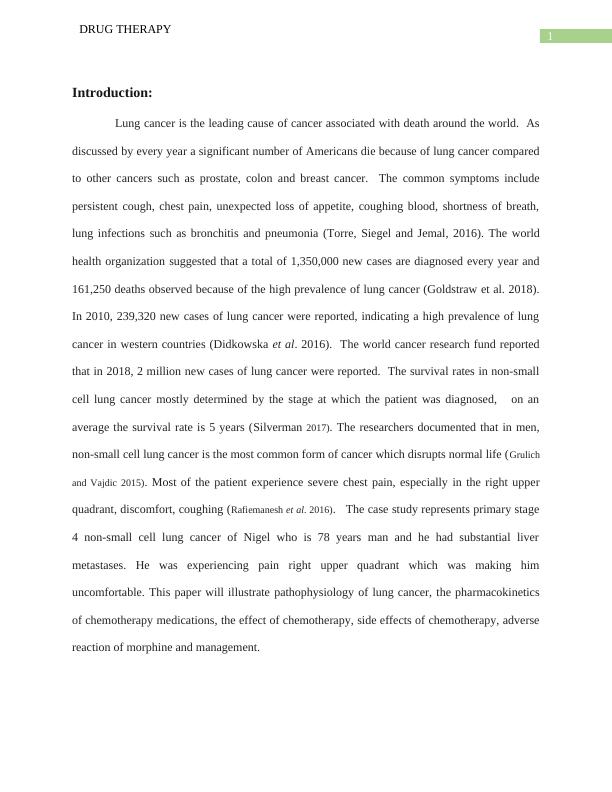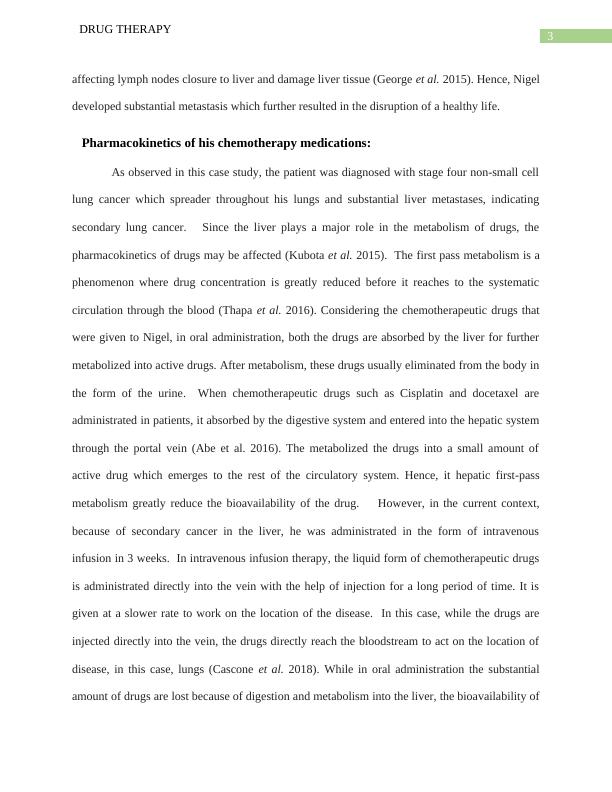Drug Therapy for Lung Cancer: Pathophysiology, Pharmacokinetics, and Side Effects
Added on 2023-03-31
16 Pages3821 Words163 Views
Running head: DRUG THERAPY
Name of the Student
Name of the University
Author Note
Name of the Student
Name of the University
Author Note

1
DRUG THERAPY
Introduction:
Lung cancer is the leading cause of cancer associated with death around the world. As
discussed by every year a significant number of Americans die because of lung cancer compared
to other cancers such as prostate, colon and breast cancer. The common symptoms include
persistent cough, chest pain, unexpected loss of appetite, coughing blood, shortness of breath,
lung infections such as bronchitis and pneumonia (Torre, Siegel and Jemal, 2016). The world
health organization suggested that a total of 1,350,000 new cases are diagnosed every year and
161,250 deaths observed because of the high prevalence of lung cancer (Goldstraw et al. 2018).
In 2010, 239,320 new cases of lung cancer were reported, indicating a high prevalence of lung
cancer in western countries (Didkowska et al. 2016). The world cancer research fund reported
that in 2018, 2 million new cases of lung cancer were reported. The survival rates in non-small
cell lung cancer mostly determined by the stage at which the patient was diagnosed, on an
average the survival rate is 5 years (Silverman 2017). The researchers documented that in men,
non-small cell lung cancer is the most common form of cancer which disrupts normal life (Grulich
and Vajdic 2015). Most of the patient experience severe chest pain, especially in the right upper
quadrant, discomfort, coughing (Rafiemanesh et al. 2016). The case study represents primary stage
4 non-small cell lung cancer of Nigel who is 78 years man and he had substantial liver
metastases. He was experiencing pain right upper quadrant which was making him
uncomfortable. This paper will illustrate pathophysiology of lung cancer, the pharmacokinetics
of chemotherapy medications, the effect of chemotherapy, side effects of chemotherapy, adverse
reaction of morphine and management.
DRUG THERAPY
Introduction:
Lung cancer is the leading cause of cancer associated with death around the world. As
discussed by every year a significant number of Americans die because of lung cancer compared
to other cancers such as prostate, colon and breast cancer. The common symptoms include
persistent cough, chest pain, unexpected loss of appetite, coughing blood, shortness of breath,
lung infections such as bronchitis and pneumonia (Torre, Siegel and Jemal, 2016). The world
health organization suggested that a total of 1,350,000 new cases are diagnosed every year and
161,250 deaths observed because of the high prevalence of lung cancer (Goldstraw et al. 2018).
In 2010, 239,320 new cases of lung cancer were reported, indicating a high prevalence of lung
cancer in western countries (Didkowska et al. 2016). The world cancer research fund reported
that in 2018, 2 million new cases of lung cancer were reported. The survival rates in non-small
cell lung cancer mostly determined by the stage at which the patient was diagnosed, on an
average the survival rate is 5 years (Silverman 2017). The researchers documented that in men,
non-small cell lung cancer is the most common form of cancer which disrupts normal life (Grulich
and Vajdic 2015). Most of the patient experience severe chest pain, especially in the right upper
quadrant, discomfort, coughing (Rafiemanesh et al. 2016). The case study represents primary stage
4 non-small cell lung cancer of Nigel who is 78 years man and he had substantial liver
metastases. He was experiencing pain right upper quadrant which was making him
uncomfortable. This paper will illustrate pathophysiology of lung cancer, the pharmacokinetics
of chemotherapy medications, the effect of chemotherapy, side effects of chemotherapy, adverse
reaction of morphine and management.

2
DRUG THERAPY
Discussion:
Lung cancer is a type of cancer which begins in the lungs. As discussed by Alexande et
al. (2016), smoking is the leading cause of lung cancer where active and passive smoker both can
be the victim of lung cancer. However, other risk factors such as exposure to radon, exposure to
asbestos, air pollution, certain dietary supplements with beta carotene are also a contributor to
lung cancer (Stone et al. 2018). The researchers documented that these risk factors facilitate the
damage of cell limes of lungs which further causes immediate damage to lung tissues. Taking an
insight into the situation, Nigel was suffering from stage 4 non-small cell lung cancer which
widespread throughout his lungs and showed metastases. Stage IV non-small longer cancer is the
most advanced form of epithelial lung cancer which manifested as difficulties in breathing and
metastasis. The non-small cell lung cancer is developed in patients when epithelial cells of the
lungs become abnormal and begin to grow exponentially. In advance stage, the lung cancer
spread other parts of the body followed by showing an array of signs and symptoms (Vodermaier
et al. 2018). Considering pathophysiology, lung cancer can cause shortness of breath or
dysphonia by blocking airway which results in lack of oxygen and shortness of breath (Gazdar
and Zhou 2018). When air away is blocked by the tumor, the mucus trapped in the lungs can be
infected and causes the shortness of breathing (George et al. 2015). Hence, patients with lung
cancer usually experience difficulty in breathing as observed in this case study.
Considering the metastasis of cancer, the non-small cell lung cancer is any type of cancer
which affects the epithelial cells. While in the advantages of lungs, it can speed to the lymph
node, brain kidney, and liver non-small cell lung cancer (O'byrne et al. 2016). Metastases most
commonly develop when cancer cells break away from the main tumor and reach the
bloodstream or lymphatic system. Since the lungs are situated immediately adjacent to the liver,
the cancer cells break from the main tumor and affect the normal function of the liver by
DRUG THERAPY
Discussion:
Lung cancer is a type of cancer which begins in the lungs. As discussed by Alexande et
al. (2016), smoking is the leading cause of lung cancer where active and passive smoker both can
be the victim of lung cancer. However, other risk factors such as exposure to radon, exposure to
asbestos, air pollution, certain dietary supplements with beta carotene are also a contributor to
lung cancer (Stone et al. 2018). The researchers documented that these risk factors facilitate the
damage of cell limes of lungs which further causes immediate damage to lung tissues. Taking an
insight into the situation, Nigel was suffering from stage 4 non-small cell lung cancer which
widespread throughout his lungs and showed metastases. Stage IV non-small longer cancer is the
most advanced form of epithelial lung cancer which manifested as difficulties in breathing and
metastasis. The non-small cell lung cancer is developed in patients when epithelial cells of the
lungs become abnormal and begin to grow exponentially. In advance stage, the lung cancer
spread other parts of the body followed by showing an array of signs and symptoms (Vodermaier
et al. 2018). Considering pathophysiology, lung cancer can cause shortness of breath or
dysphonia by blocking airway which results in lack of oxygen and shortness of breath (Gazdar
and Zhou 2018). When air away is blocked by the tumor, the mucus trapped in the lungs can be
infected and causes the shortness of breathing (George et al. 2015). Hence, patients with lung
cancer usually experience difficulty in breathing as observed in this case study.
Considering the metastasis of cancer, the non-small cell lung cancer is any type of cancer
which affects the epithelial cells. While in the advantages of lungs, it can speed to the lymph
node, brain kidney, and liver non-small cell lung cancer (O'byrne et al. 2016). Metastases most
commonly develop when cancer cells break away from the main tumor and reach the
bloodstream or lymphatic system. Since the lungs are situated immediately adjacent to the liver,
the cancer cells break from the main tumor and affect the normal function of the liver by

3
DRUG THERAPY
affecting lymph nodes closure to liver and damage liver tissue (George et al. 2015). Hence, Nigel
developed substantial metastasis which further resulted in the disruption of a healthy life.
Pharmacokinetics of his chemotherapy medications:
As observed in this case study, the patient was diagnosed with stage four non-small cell
lung cancer which spreader throughout his lungs and substantial liver metastases, indicating
secondary lung cancer. Since the liver plays a major role in the metabolism of drugs, the
pharmacokinetics of drugs may be affected (Kubota et al. 2015). The first pass metabolism is a
phenomenon where drug concentration is greatly reduced before it reaches to the systematic
circulation through the blood (Thapa et al. 2016). Considering the chemotherapeutic drugs that
were given to Nigel, in oral administration, both the drugs are absorbed by the liver for further
metabolized into active drugs. After metabolism, these drugs usually eliminated from the body in
the form of the urine. When chemotherapeutic drugs such as Cisplatin and docetaxel are
administrated in patients, it absorbed by the digestive system and entered into the hepatic system
through the portal vein (Abe et al. 2016). The metabolized the drugs into a small amount of
active drug which emerges to the rest of the circulatory system. Hence, it hepatic first-pass
metabolism greatly reduce the bioavailability of the drug. However, in the current context,
because of secondary cancer in the liver, he was administrated in the form of intravenous
infusion in 3 weeks. In intravenous infusion therapy, the liquid form of chemotherapeutic drugs
is administrated directly into the vein with the help of injection for a long period of time. It is
given at a slower rate to work on the location of the disease. In this case, while the drugs are
injected directly into the vein, the drugs directly reach the bloodstream to act on the location of
disease, in this case, lungs (Cascone et al. 2018). While in oral administration the substantial
amount of drugs are lost because of digestion and metabolism into the liver, the bioavailability of
DRUG THERAPY
affecting lymph nodes closure to liver and damage liver tissue (George et al. 2015). Hence, Nigel
developed substantial metastasis which further resulted in the disruption of a healthy life.
Pharmacokinetics of his chemotherapy medications:
As observed in this case study, the patient was diagnosed with stage four non-small cell
lung cancer which spreader throughout his lungs and substantial liver metastases, indicating
secondary lung cancer. Since the liver plays a major role in the metabolism of drugs, the
pharmacokinetics of drugs may be affected (Kubota et al. 2015). The first pass metabolism is a
phenomenon where drug concentration is greatly reduced before it reaches to the systematic
circulation through the blood (Thapa et al. 2016). Considering the chemotherapeutic drugs that
were given to Nigel, in oral administration, both the drugs are absorbed by the liver for further
metabolized into active drugs. After metabolism, these drugs usually eliminated from the body in
the form of the urine. When chemotherapeutic drugs such as Cisplatin and docetaxel are
administrated in patients, it absorbed by the digestive system and entered into the hepatic system
through the portal vein (Abe et al. 2016). The metabolized the drugs into a small amount of
active drug which emerges to the rest of the circulatory system. Hence, it hepatic first-pass
metabolism greatly reduce the bioavailability of the drug. However, in the current context,
because of secondary cancer in the liver, he was administrated in the form of intravenous
infusion in 3 weeks. In intravenous infusion therapy, the liquid form of chemotherapeutic drugs
is administrated directly into the vein with the help of injection for a long period of time. It is
given at a slower rate to work on the location of the disease. In this case, while the drugs are
injected directly into the vein, the drugs directly reach the bloodstream to act on the location of
disease, in this case, lungs (Cascone et al. 2018). While in oral administration the substantial
amount of drugs are lost because of digestion and metabolism into the liver, the bioavailability of

End of preview
Want to access all the pages? Upload your documents or become a member.
Related Documents
Nursing Assignment on Lung Cancer and Chemotherapy Medicationlg...
|12
|3386
|142
Lung Cancer: Pathophysiology, Pharmacokinetics, and Treatmentlg...
|14
|3484
|321
Stage IV NSCLC: Pathophysiology, Symptoms, and Prognosislg...
|11
|4606
|32
Non-Small Cell Lung Cancer: Pathophysiology, Pharmacodynamics, and Effectiveness of Chemotherapy Drugslg...
|15
|4249
|260
Chemotherapy of Lung Cancerlg...
|14
|4448
|29
Impact of NSCLC on Nigel's Breathing Difficulty and Liver Metastasislg...
|11
|4721
|58
